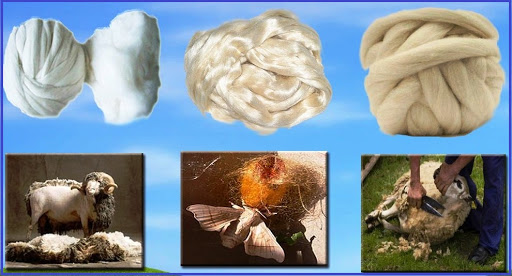Weaving:
Weaving is the textile art in which two threads, named warp and weft are interlaced with each other at right angles to make cloth or fabric
The warp threads run vertically on the piece of fabric, while the weft runs horizontally. Fabric is woven on a loom, a device for holding the warp threads in place while the weft threads are woven through them, back and forth.
The weft is an old English word meaning "that which is woven". Woven cloth can be plain (in one color or a simple pattern), or it can be woven in artistic designs.
Basic weaving method
Shedding
Picking
Beating in
Shedding:
The vertical space between the raised and upraised warp yarns called shed, and the process is called shedding. The yarns are passed through the eye holes of the heddles, which hang vertically from the harnesses.(the frame with headdles is known as the harness frame). The weave pattern determines which harness controls which warp yarns, and the number of harnesses used depends on the complexity of the weave.
Picking:
The space between two warp yarns (down raised and upraised) also known as a shed, the weft yarn is inserted using a carrier called the shuttle, this process is called picking. In modern looms like air jet or water jet, the weft is not carried by shuttle but with air blow or water pressure.
Beating in:
Between the heddles and the take-up roll, the warp threads pass through another frame called the reed (which is similar to a comb). The portion of the fabric that has already been formed but not yet rolled up on the take-up roll is called the fell. After the shuttle moves across the loom laying down the fill yarn, the weaver uses the reed to press (or batten) each filling yarn against the fell.
Back Process for weaving:
Warping
Sizing
Drawing
Warping
This is the process where warp yarn is rolled on a beam called warp beam.
Types of Warping:
Beam/Direct warping • (Gray/Monocolour fabric)
Sectional/Indirect warping • (Warp patterns: Stripes and Checks)
Ball warping • (Denim fabric)
Sizing:
A chemical applied on warp yarn to give strength to yarn so that it cannot break with friction and tension of loom, this process is called sizing. A wide variety of sizing materials are used including starch, polyvinyl alcohol, carboxymethyl cellulose, gums, glues, acrylic film, synthetic polymers, and copolymers. For staple-fiber yarns (or spun yarns), starch and polyvinyl alcohol are the size films most often used.
“Sizing is half weaving”
Drawing:
After sizing warp yarn ends are passed through headdles and reed, this is called drawing. Drawing the process responsible for designs of fabrics



























